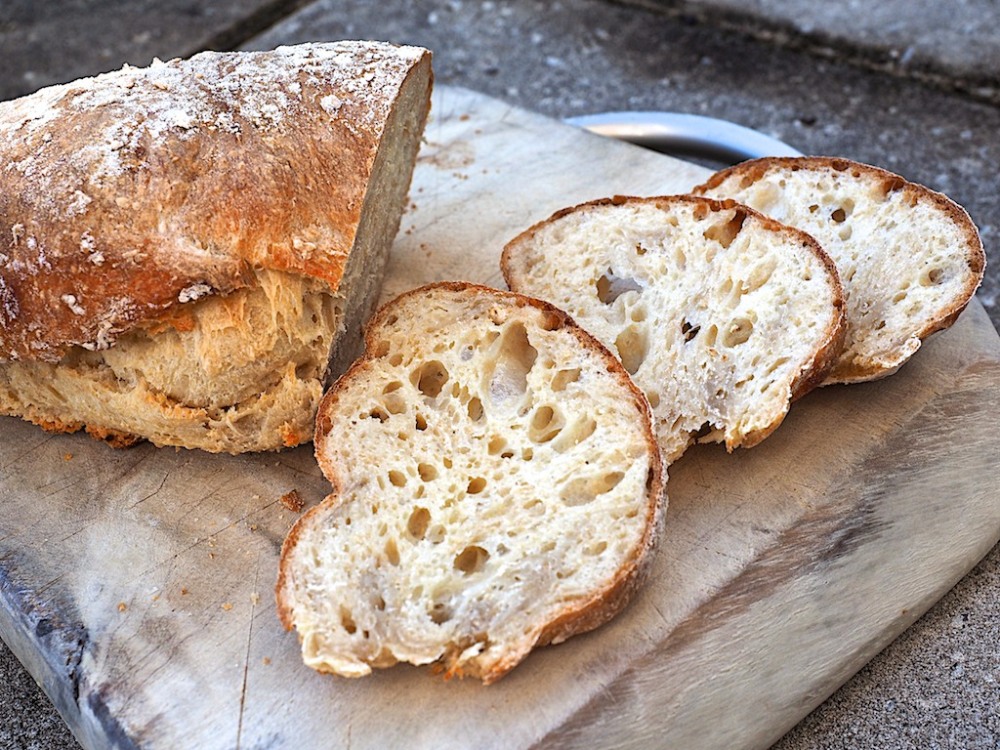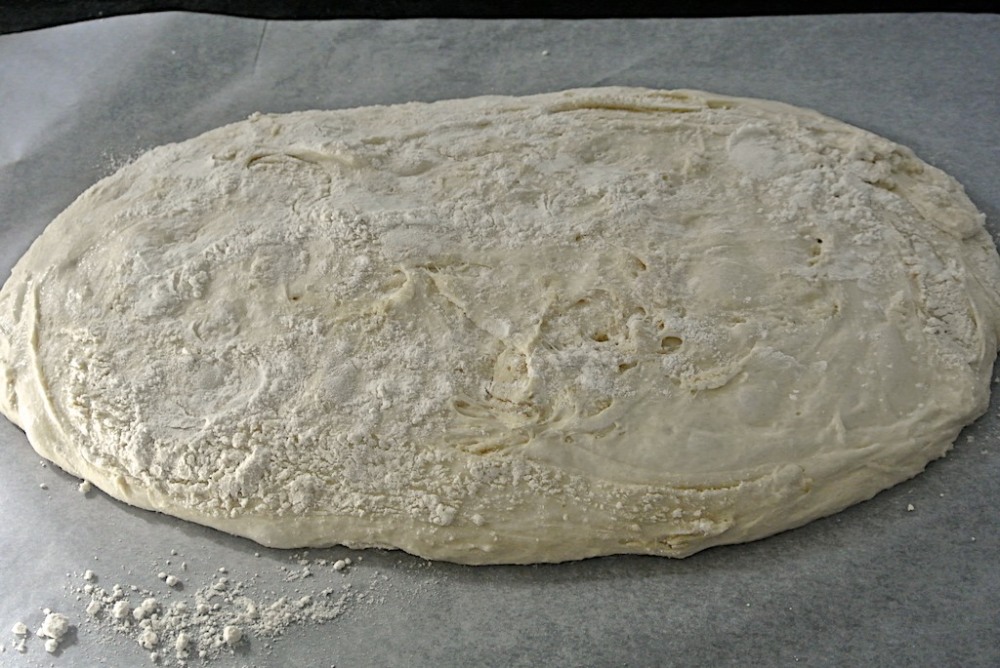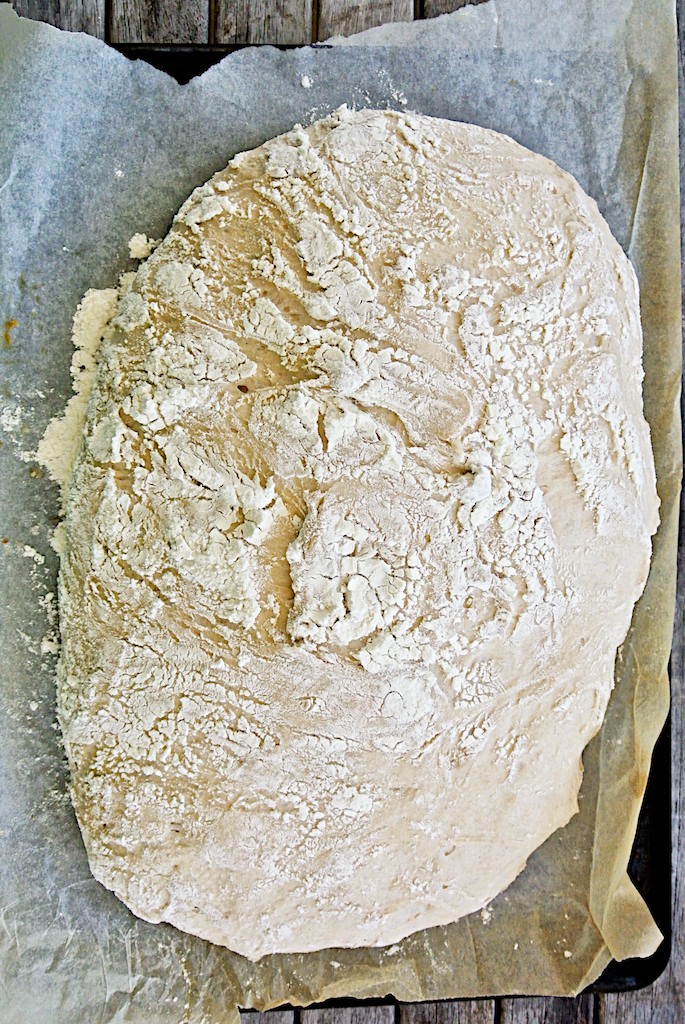Ciabatta Bread
Ciabatta Bread
 As much as it is true that one should not judge a book by its cover, you can safely go about life judging a good Ciabatta by the holes in its crumb! And this is one particular instance when size does matter: the bigger the holes, the better the loaf…The secret to a perfect Ciabatta is in the percentage of water in the dough, a dough that is sticky, wet and fun to manipulate. This is not your classic “knead for ten minutes” dough. In fact, you hardly have to knead it at all. So, where’s the catch? No, catch. Ciabatta, it turns out, is a home-baker’s new best friend.
As much as it is true that one should not judge a book by its cover, you can safely go about life judging a good Ciabatta by the holes in its crumb! And this is one particular instance when size does matter: the bigger the holes, the better the loaf…The secret to a perfect Ciabatta is in the percentage of water in the dough, a dough that is sticky, wet and fun to manipulate. This is not your classic “knead for ten minutes” dough. In fact, you hardly have to knead it at all. So, where’s the catch? No, catch. Ciabatta, it turns out, is a home-baker’s new best friend.
INGREDIENTS , if using dry yeast
450 gr (3 3/4 cups) of flour
350 ml (1 1/4 cup) water at room temperature
a tablespoon of olive oil
1 scant tablespoon of dry yeast
2 teaspoons of salt
HOW TO
1. In a large bowl, mix together flour, water oil and yeast. When the yeast is well incorporated, add the salt.
2. Mix vigorously with a spatula or with a standing mixer fitter with a paddle attachment for 5-10 minutes or until the dough is shiny and slightly elastic. It will be sticky and wet. Put in an oiled bowl to prove for 30 minutes, then stretch it with wet hands and fold it onto itself and leave to rest. At this stage you have two options: place the covered bowl in the fridge to slow prove overnight , or for a minimum of 10 hours, or prove at room temperature, in a warm spot, for a further 1 1/2-2 hours or until doubled in size. Slow proving will add flavour and will ensure you a moist soft crumb, but you will still have a worthy ciabatta if you skip that stage. Up to you and your own time management, really! Once the dough has proven, you will notice that lovely air bubbles will have formed. Don’t burst them, they hold the secret to the formation of those coveted holes. Tip the dough onto a baking tray lined with parchment paper, stretch it gently with floured hands and dimple the top lightly.
3. Place a metal bowl or a small skillet in the oven and bring the oven temperature to to 200 C (395 F)
4. Insert the bread tray into the hot oven, pour a glass of cold water into the skillet to create steam, close the oven door and bake for 30-35 minutes or until risen, golden and the bottom sounds hollow when tapped. You may need to flip the bread upside down to ensure even baking according to your oven. Cool at room temperature over a wire rack for at least 1 hour before slicing away to reveal that holey, moist crumb.
You can also make Ciabatta using an active sourdough starter. The flavour and longevity of your bread will be incomparably better.
Follow this link if you wish to make your sourdough starter
Sourdough ciabatta
In a large non-metal bowl mix 230 gr (1 cup) of sourdough, 380 (3 cups) gr of plain flour and 260 ml (1 cup) of filtered water at room temperature and a tablespoon of olive oil. When the ingredients are well amalgamated, add 2 teaspoonsof salt and mix well with a wooden spoon. Cover your bowl with either a lid or oiled cling wrap and let it rest overnight. Be mindful not to leave your dough to prove in a drafty spot. In the morning your dough will have more than doubled its volume. Using a spatula, scrape it onto an oven tray lined with grease-proof paper, dust the top with a little flour and let it prove for an hour or two. The proceed as step 4. You will find that your ciabatta will not puff up much in the oven, it will stay quite flat, like a slipper, hence its name (ciabatta means slipper in Italian)
As hard as it will be, allow to cool down before you attempt to slice it…
Silvia’s Cucina is on Facebook , Twitter and Pinterest






